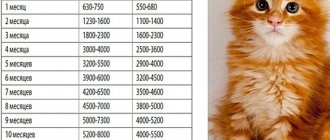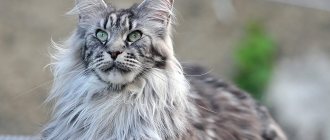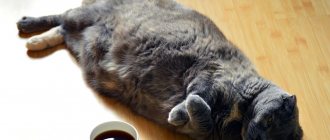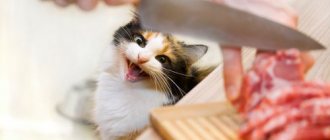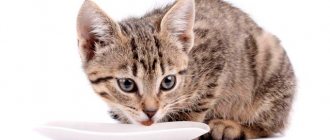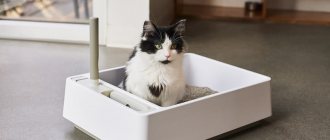How can you not worry about your kitten? He is so small and defenseless, he cannot tell his owner whether there is enough food or not. So the owner is trying: he constantly feeds the baby, because the poor thing is too thin.
What age is the baby? Three months? Great, we have to find out how much a kitten should weigh at 3 months. And after that, decide whether he is really skinny, or whether the owner decided so.
From birth to...
Before we get to our main task, let's talk about how cat babies gain weight.
Birth weight often does not reach 100 grams, unless we are talking about a large breed such as the Maine Coon. Kittens of these breeds weigh about 150 grams at birth.
During the first month of life, the baby gains weight 4-5 times its original weight. A one-month-old kitten already weighs 400-500 grams.
By the age of two months, its weight can be 600-700 g. Maine coons and other large breeds can weigh 900 g.
The normal weight of a kitten at 3 months is from 1200 to 1500 grams. But there are some factors to consider here. Which? We'll find out in the next subsection.
What to feed newborn kittens without a cat?
The best option is a cat milk replacer. If for some reason this is not possible, you can prepare a mixture similar in composition to cat milk according to the following recipes:
- Baby formulas. Milk is prepared twice as liquid as for a baby in the first week of life.
- For 100 ml of cow's milk add one chicken yolk, 7 ml of 5% glucose and 3 drops of tetravit.
- Dilute 5 ml of cream 10% fat with boiled water in a volume of 3 ml and add 2 ml of 5% glucose.
- Goat milk mixed with water.
Factors affecting weight
It all starts from the moment the cat is pregnant. It is no secret that the further development of a kitten, including its weight, is influenced by intrauterine formation. Did the fetus receive the required amount of vitamins and nutrients?
- Nutrition of the expectant mother is a key factor in the formation of the fetus and its subsequent development.
- The nutritional value of mother's milk plays an important role.
- Does the baby have enough milk? If not, then he may be slightly behind in physical development from more “well-fed” kittens.
- Number of brothers and sisters. The larger the litter, the harder it is for the cat to feed it.
- Nutrition after weaning. It is clear that a stray kitten, which knows the feeling of hunger from an early age, will weigh less than its domestic counterpart.
- Seals are larger than female cats, so they will weigh more.
The weight of a 3-month-old kitten depends on such seemingly not very significant factors.
Some external features
All representatives of the breed, regardless of their color, place of residence and characteristics of care, have a number of appearance characteristics. Using them, you can determine the kitten’s species:
- Round head, wide cheekbones and short neck;
- Short and straight nose, small and low-set rounded ears;
- Big eyes;
- Grounded, massive body;
- Short, but quite thick paws;
- Thick, medium-sized tail;
- Short but very thick coat.
3 month old British babies © shutterstock
Breed and weight
Two friends decided to get cats. One bought a Maine Coon, and the second decided on a Siamese kitten. The “kids” are the same age and are fed very well. But why does the Maine Coon look like a lynx? Plump, heavy, pleasant to touch. And a representative of the Siamese breed resembles a skeleton: skinny, disproportionately long, and you can count the ribs.
Because the breeds are completely different. And this means that the weight of a kitten at 3 months of one breed will be significantly different from another.
So that the owners are not afraid of the “wrong” weight of their pet, they need to know this:
- At the age of three months, the Maine Coon weighs 1700-2300 grams.
- A Scottish kitten at the same age will weigh 1000-1500 grams.
- A British baby weighs the same as a Scottish baby.
- A Siamese kitten barely reaches a weight of 1000 grams.
- Sphynxes can weigh from 800 to 1300 grams.
- Ordinary noble representatives of cats - from 700 to 1000 grams.
What should kittens not be given during their growth period?
- Cow's milk is not suitable for kittens; it does not provide the body's basic needs and is difficult to digest.
- Raw river fish – causes a lack of vitamin B and helminthic infestations.
- Fermented milk and dairy products with a high fat content.
- Fatty meats, pork.
- Sausages, smoked meats, products containing salt and spices.
- Potatoes and legumes are not digestible by cats; in addition, legumes cause fermentation in the intestines.
- Flour products and sweets do not bring any benefit to the body and contribute to excess weight gain.
- Chocolate is dangerous for cats and contains a substance that is toxic to this type of animal.
Pathology
How much should a kitten weigh at 3 months of age? From 700 to 2300 grams. It depends on the breed. The average weight ranges from 1200 to 1500 grams.
What if the pet exceeds its weight category? A slight excess cannot be called critical. 100 grams is nonsense. In the case when a pet looks more like a small ball than a cute kitten, we are talking about a pathological weight disorder. And what should the owner do?
First of all, have your pet examined by a veterinarian. Cats are prone to diseases, the symptom of which is weight gain. If the veterinarian rules out their development, then you will have to reconsider the pet’s diet. He also diagnoses obesity in the baby.
Same problem, only from the other side. The kitten does not weigh enough. But at the same time he is active, mobile, curious and has a good appetite. It wouldn't hurt to visit a veterinarian. Has the cat and dog doctor ruled out diseases? Great, people can be too thin too. They eat pretty well though. You should not try to fatten the kitten, let him eat as much as he wants.
Amount of water when feeding a kitten dry food
In order for the kitten’s body systems to function at a high level, along with the necessary substances, the minerals contained in the water must also be supplied.
Water, in itself, is not a source of energy, but is a special substance necessary for the passage of biochemical reactions, serves as a natural solvent, and takes part in the processes of respiration, blood circulation and, of course, digestion.
When your pet consumes dry food, the amount of drinking water should be unlimited. So, you should not force a cat to drink water, but there should always be access to water. Otherwise, there is a high risk of serious diseases associated with disruption of the urinary system. First of all, when there is a lack of fluid in the body, it is the kidney structures that suffer.
Feeding and maintenance
We found out how much a kitten should weigh at 3 months. Now let's talk about how to feed the little furry little prankster. And how to care for it.
Let's start with nutrition. The owner needs to remember that a lot depends on a balanced diet. Please do not feed your baby with economy class kitten food. Yes, they are available and cheap. But the quality is lacking on both legs. Feeding a kitten this kind of food is the same as feeding a human child instant noodles. Is there much use in it? And how long will you be healthy enough to digest this crap?
What if you don’t have money for good food? He's expensive. Feed natural food, this is not a problem. Chicken and turkey are not the most expensive meats. Vegetables and cereals are also not incredibly expensive products.
Milk is getting more expensive, it’s true. But there is no need to give milk to a three-month-old animal every day. It won't do any good. Three times a week you can pamper yourself with kefir and cottage cheese. Once a week, give a boiled egg, or rather a half or a quarter of it.
Did the owner finally decide to feed? Let him choose super-premium class or holistic. They are not cheap, but the quality is simply excellent.
We sorted out the diet. Let's move on to the content. What does the baby need?
- A lounger or a rest house. The kitten will sleep in it and hide when it needs to be alone.
- Scratching post. You can buy the simplest one, mounted on the wall. Or you can take a whole cat town with a scratching post, a house and toys. It all depends on the financial situation of the owners.
- Bowl for water and food.
- Toys.
- Nail clippers or nail scissors. Useful from the age of six months for trimming nails.
- Cotton swabs. Needed to remove discharge from the eyes. The kitten is examined daily. The owner checks the cleanliness of the ears and eyes. Dirt and discharge are removed using a dampened swab. The ears are cleaned with cotton swabs.
- We now know how much a kitten should weigh at 3 months. By the way, scales will be very useful for him.
- Tray and filler. The kitten has done its business, the spoiled litter is removed immediately, and a new one is added in its place.
Long-haired breeds require regular brushing. Kittens and cats should not be washed frequently. Twice a year is enough.
Determining age by behavior
How strange: spoiled children, especially strangers, usually cause us irritation; at best, we do our best to restrain ourselves, trying to be tolerant. But looking at the raging kittens, ready to destroy the whole house in their noisy games, a stupid, touching smile stretches even the faces of stern people.
Kitten games are always a delight
One day, an indignant neighbor rang the author’s doorbell, haunted by the constant roar coming from above. Having crossed the threshold, the man looked for several minutes at the three-month-old kittens, selflessly chasing an empty plastic bottle around the floor, then thoughtfully asked: “How much does it cost?” - and went for the money.
Determining the age of a kitten by its behavior is much more pleasant than looking into the mouth of a small predator and counting its teeth.
Learning to walk
Babies take their first hesitant steps towards the end of the second week of life. At first, it is difficult for them to maintain balance; they sway funny even when sitting, and when they rise to their feet, they have difficulty supporting their plump body on them. Gradually, the forays from the nest become more and more distant, and finally, the bravest one completes the inspection of the entire house.
Between two weeks and a month, babies learn not only to walk, but also to run, jump and climb vertical surfaces using their claws. Having fallen from a height (for example, from a sofa), the baby no longer plops down on the floor with his whole body, but gracefully lands on his paws, deftly turning around in the air.
Month-old kittens run around the house like mad, often knocking over objects in their path.
Hunting is the most important skill for a kitten
By two months, children gradually master hunting skills, their movements and games become more and more “adult”.
From three to six months, the childhood age of small cats is revealed only by excessive activity and immoderate curiosity. By the way, it is during this period that animals often get into trouble, sometimes ending in tragedy.
The author had to endure several terrible hours when his four-month-old cat, having inexplicably slipped through the opened door, decided to explore the new territory and fell into the open hatch of the garbage chute, flying nine floors. Fortunately, the landing was successful: the janitor heard a plaintive meow, and the prodigal daughter was returned to her family.
Learning to eat
As mentioned, WCF strongly recommends that kittens not be separated from their mother until they are three months old. All this time, babies continue to receive mother's milk, but starting from eight weeks, this process is more an element of family communication than nutrition.
They say that kittens need to start switching to solid food at about a month of age, but the author has never had to do this: babies are remarkably “transferred” to adult food on their own when one of them first wanders into the kitchen in search of their mother and discovers her in front of a fragrantly smelling plate.
A month-old fidget will find a bowl of “adult” food on its own
One way or another, kittens begin to feed on their own (lapping and grabbing pieces of food with their teeth) from the ninth week. By this time, as we remember, they have already formed a full row of baby teeth. So, if your baby is pointlessly poking at his plate, he is most likely not yet eight weeks old.
As soon as the kitten begins to receive other food in addition to mother's milk, it is time to accustom it to the tray. Breastfed babies are licked by the cat herself, so they do not need the toilet.
In conclusion, it is worth noting that the speed at which kittens acquire all the above skills largely depends on whether there is an object to imitate nearby. The WCF requirements about the need for kittens to stay in a “full family” for a sufficiently long time are dictated precisely by the fact that for the correct formation of a cat’s character, receiving full maternal education is very important. A puppy can be taught everything necessary by a person, but in cats this function belongs to the mother.
No one can teach a kitten everything necessary for life better than its mother.
This means that if you pick up a helpless baby on the street who can neither walk nor feed himself, perhaps he will learn all this a little later than expected, so when determining the age of your pet, make allowances for his “difficult childhood” .
Video: two-month-old kittens playing next to their calm mother
Often, the age of a kitten is a closely guarded secret (unless, of course, you were personally present at its birth). But by looking closely at your pet, you can break these seals one by one. External signs (weight, size, presence and number of teeth, eye color, ear shape, coat condition, proportions), as well as behavioral characteristics should be used as “keys”. Not all of the mentioned tips have the same degree of reliability and information content, but if you study them together and correctly compare the results, the answer you receive will be very close to the truth.
British kitten 2 – 3 months
Kittens feed themselves, go to the toilet, and play. They are very curious and it is worth taking care of their safety: close the windows, remove poisonous plants, dangerous sharp toys, threads, buttons. They suck a cat out of habit; they will do this until they are weaned or the cat stops letting them come to them. The paws of kittens lengthen and no longer resemble bear cubs, all this is due to uneven development. Character begins to emerge. It is worth spending more time raising children, teaching them to use a comb and a scratching post. Two months – it’s worth carrying out the first deworming and getting vaccinated; more about vaccinations here. Three months – repeated vaccination against viral infections and rabies vaccination are carried out. After three months, the kitten is considered socially adapted and can move to a new home.
